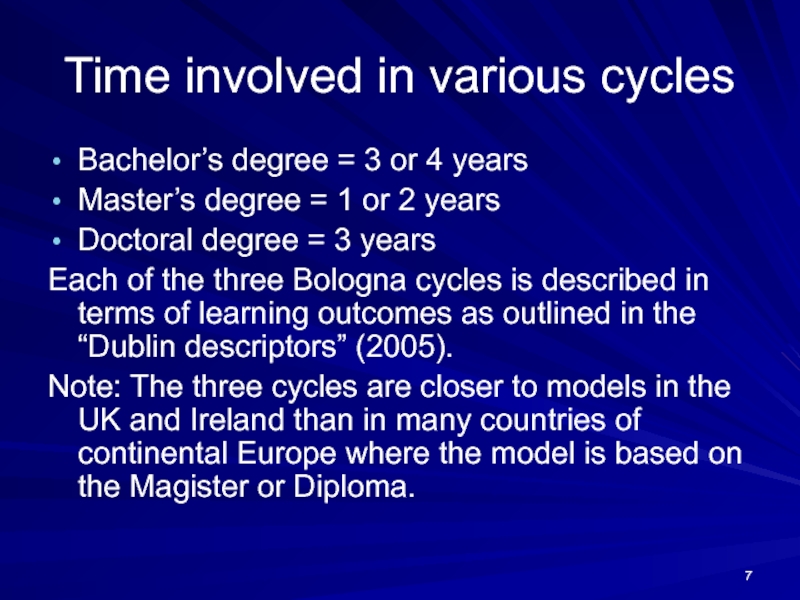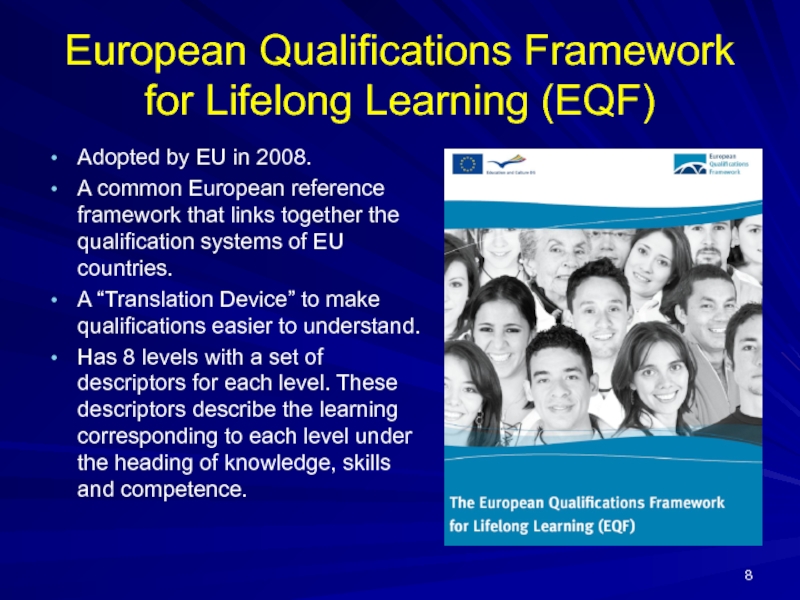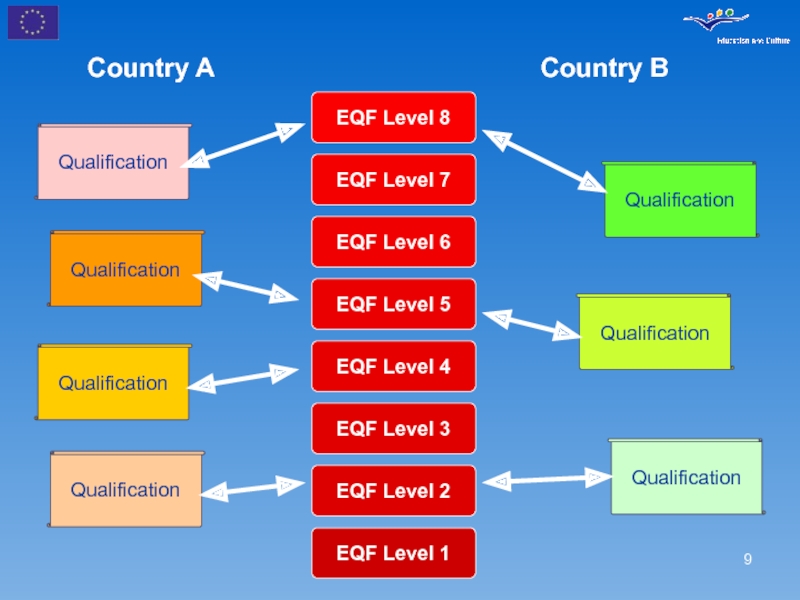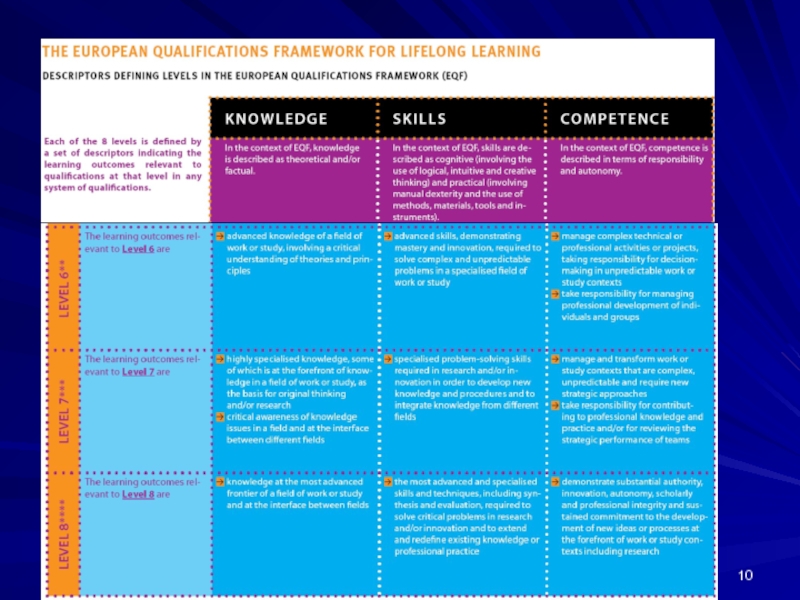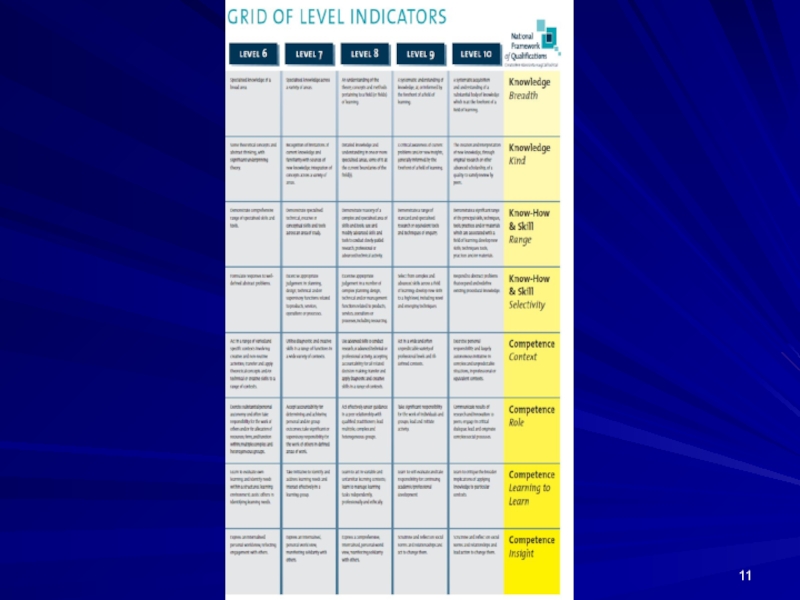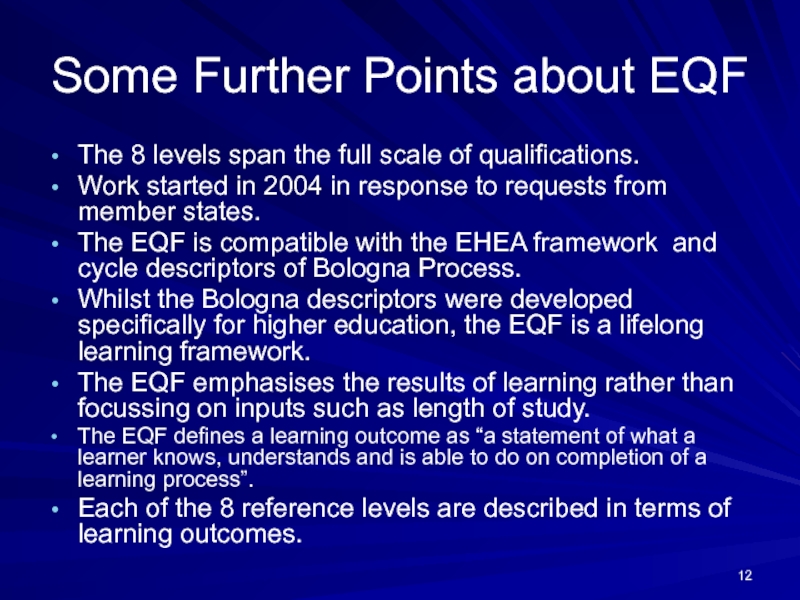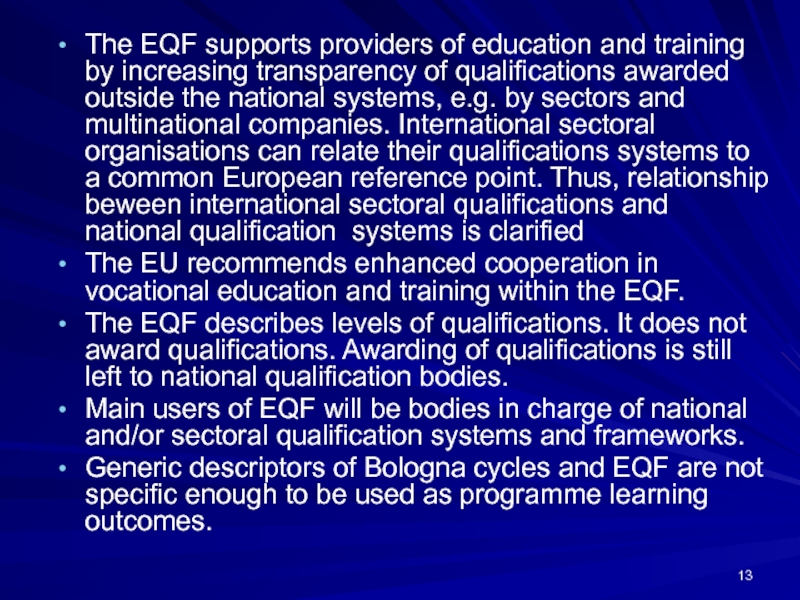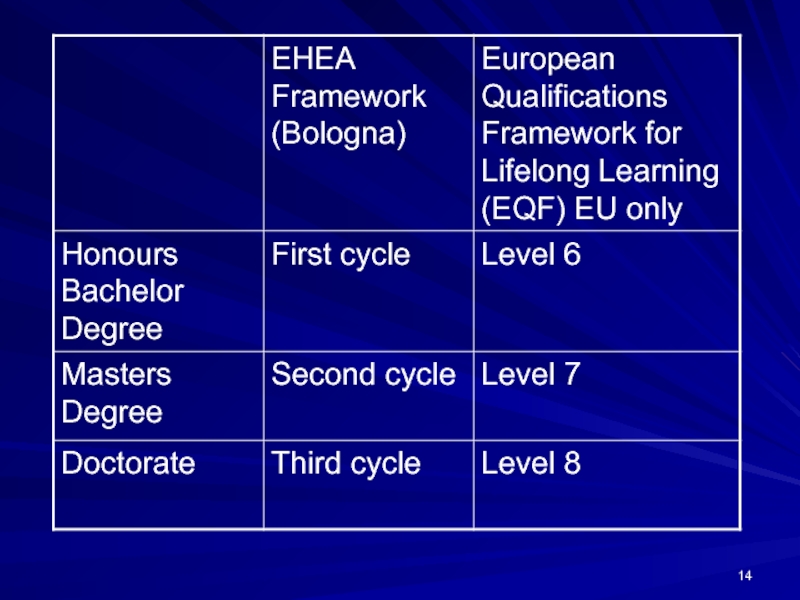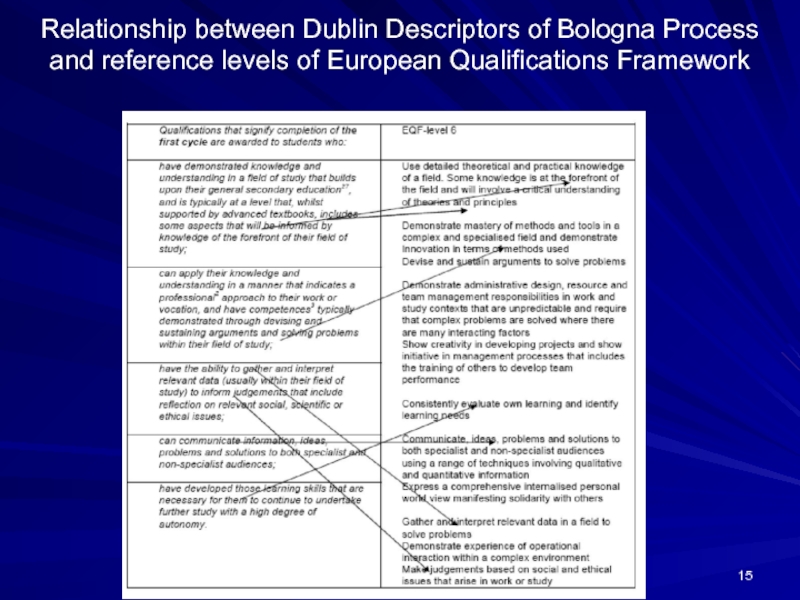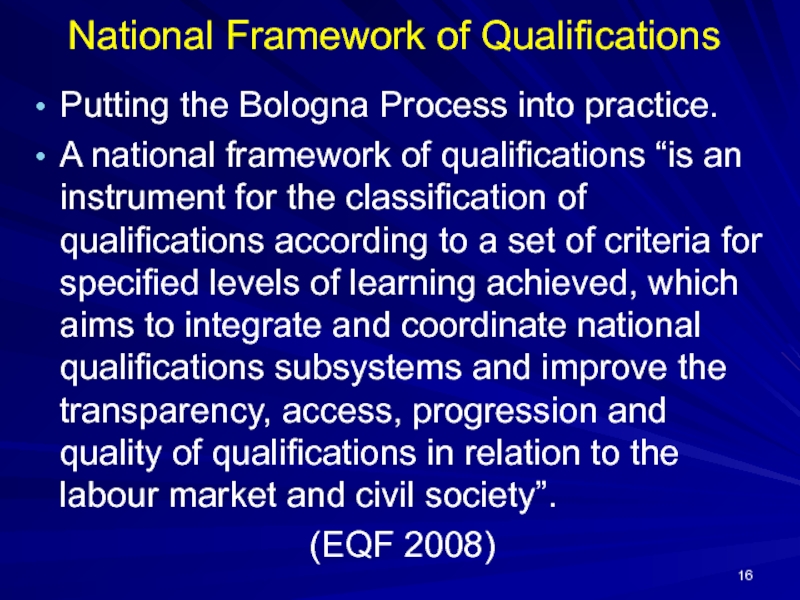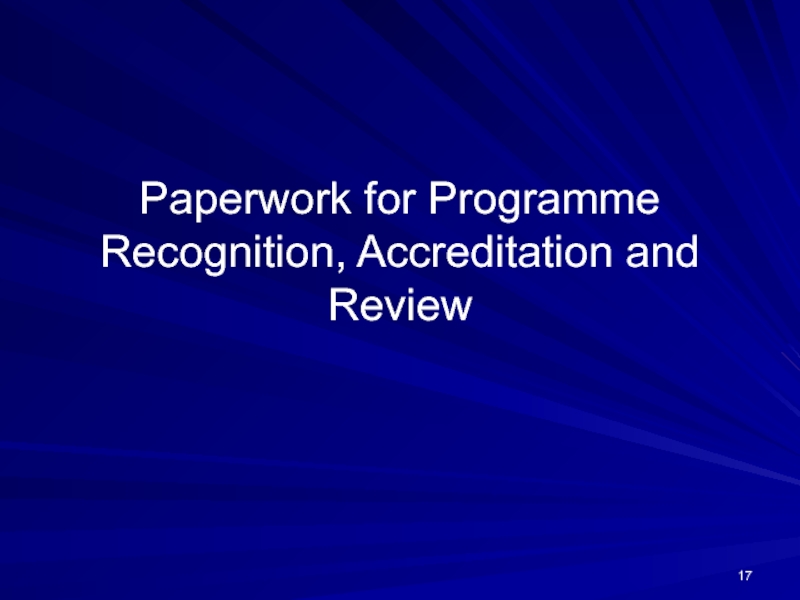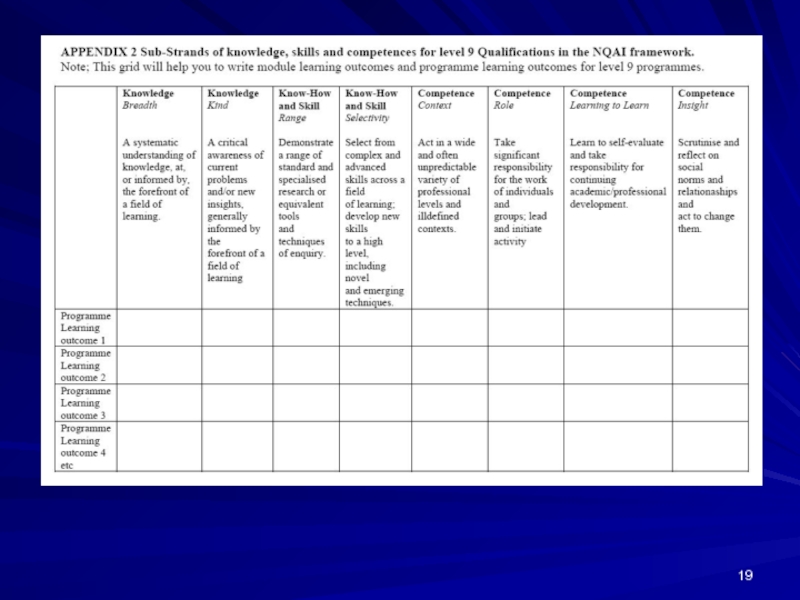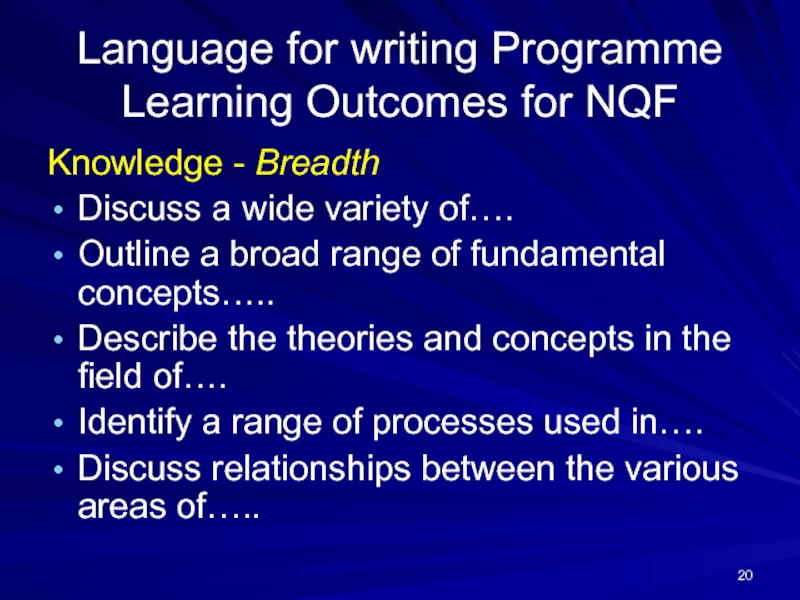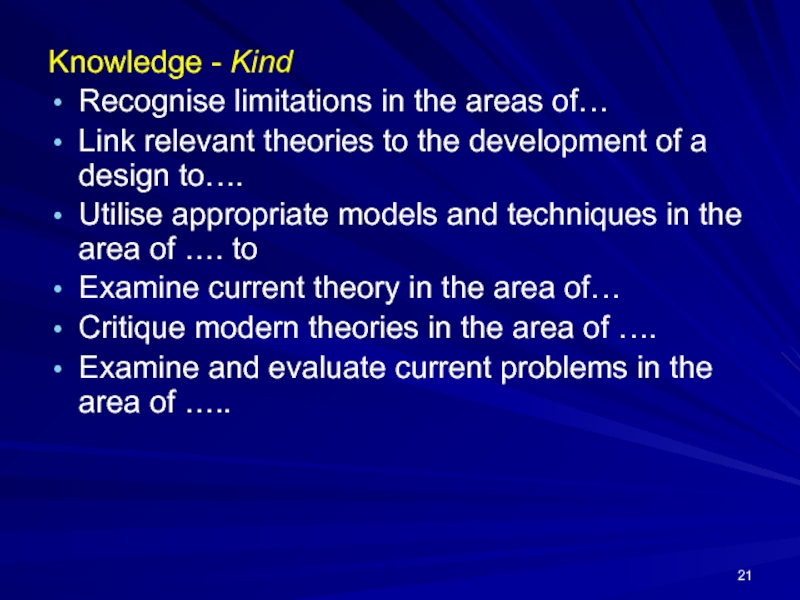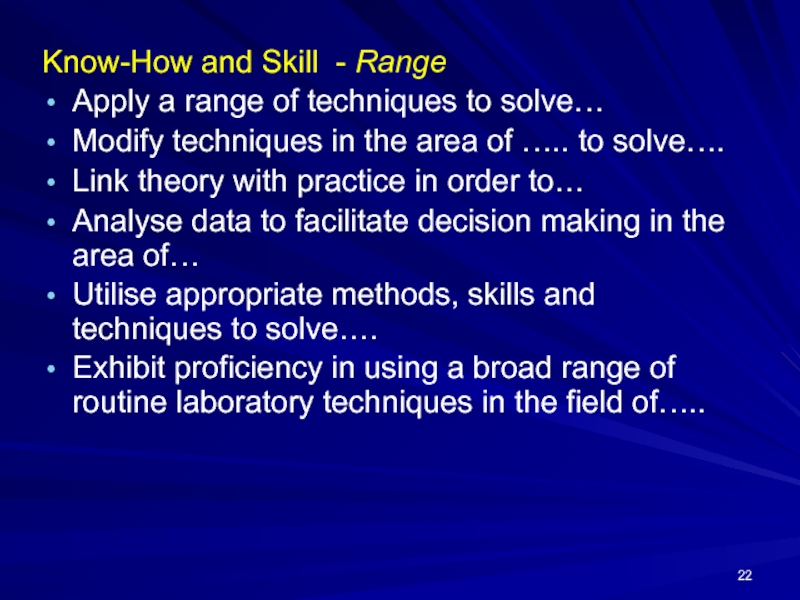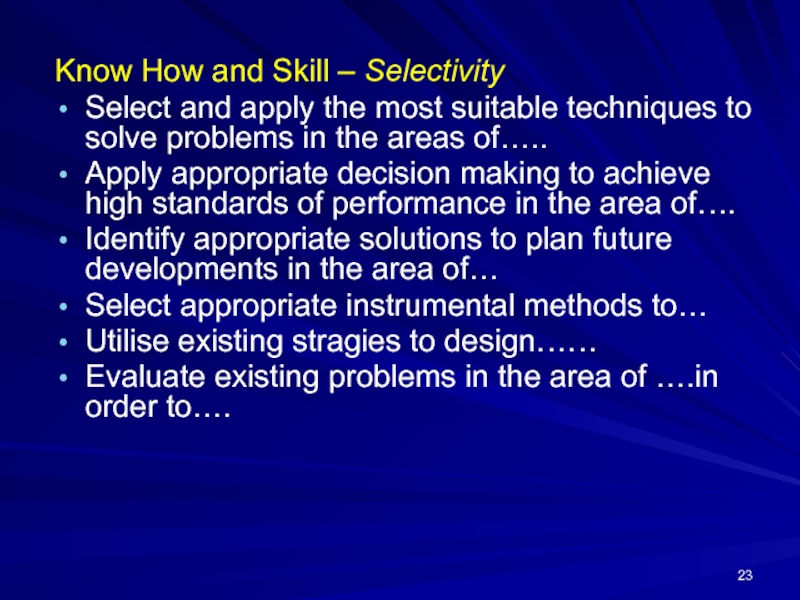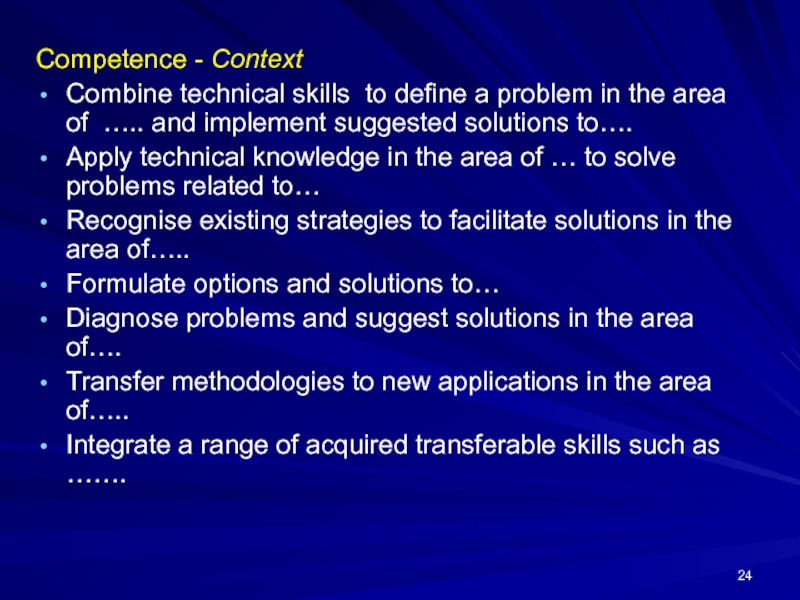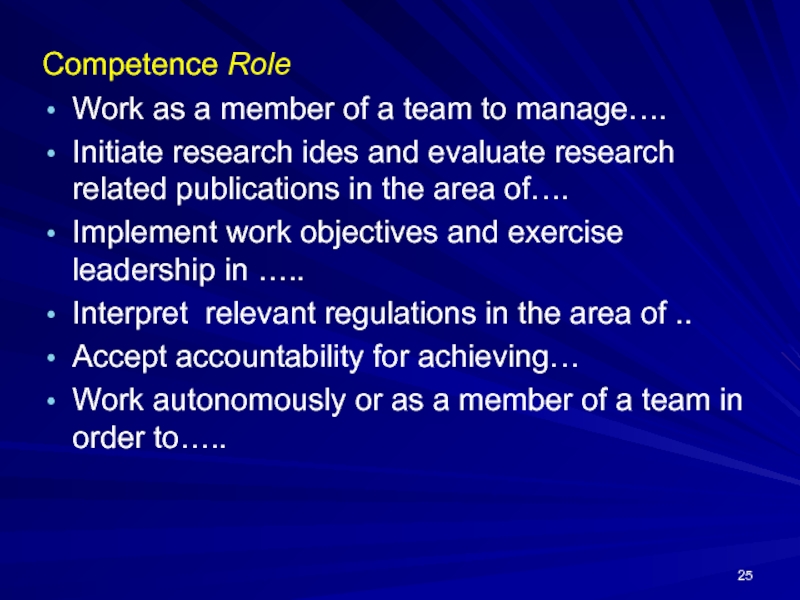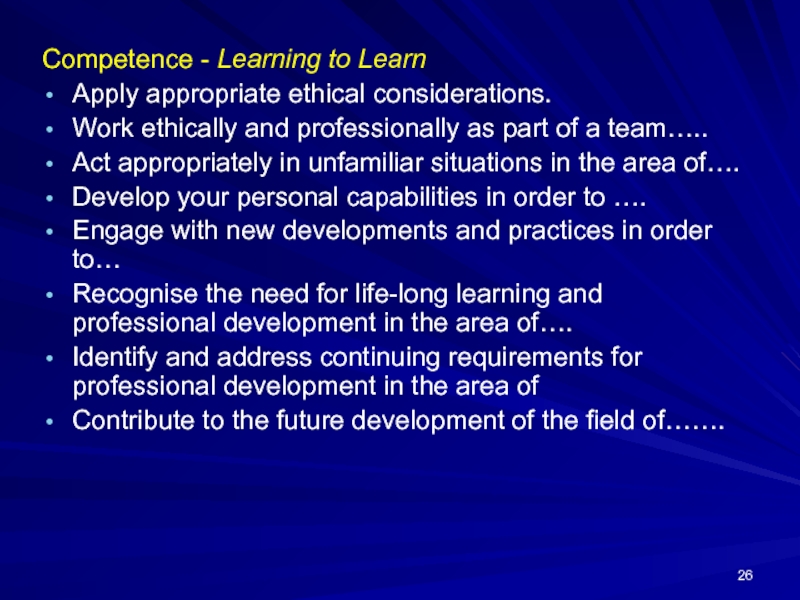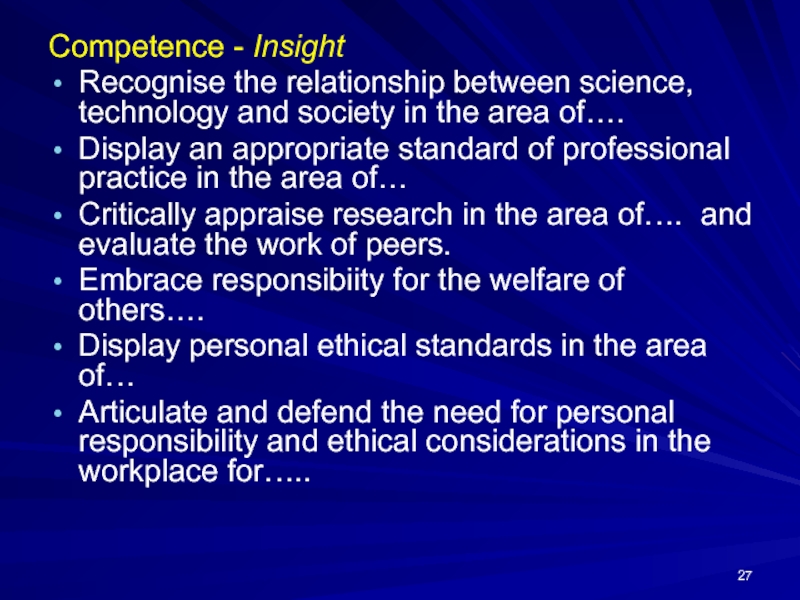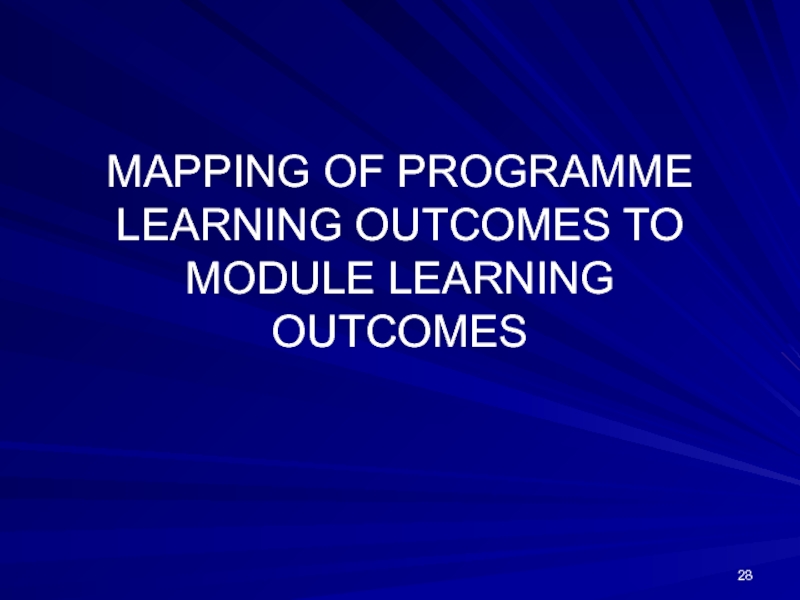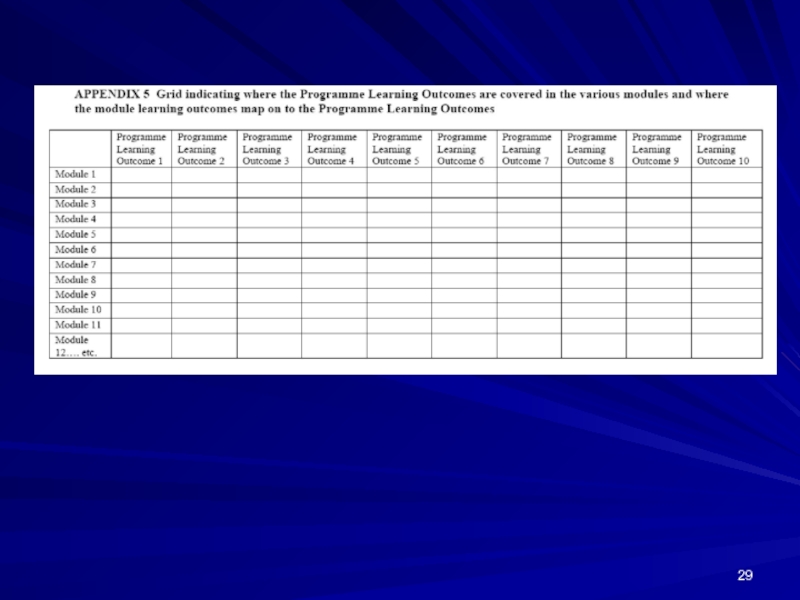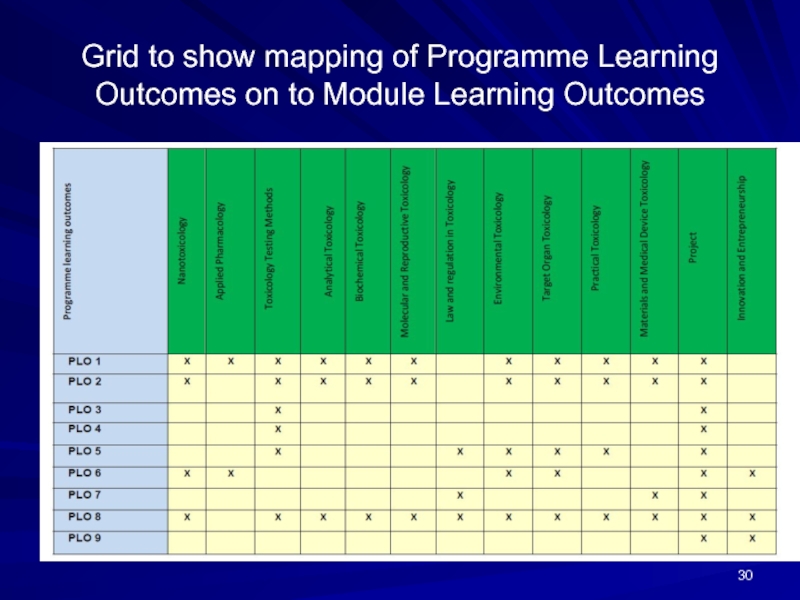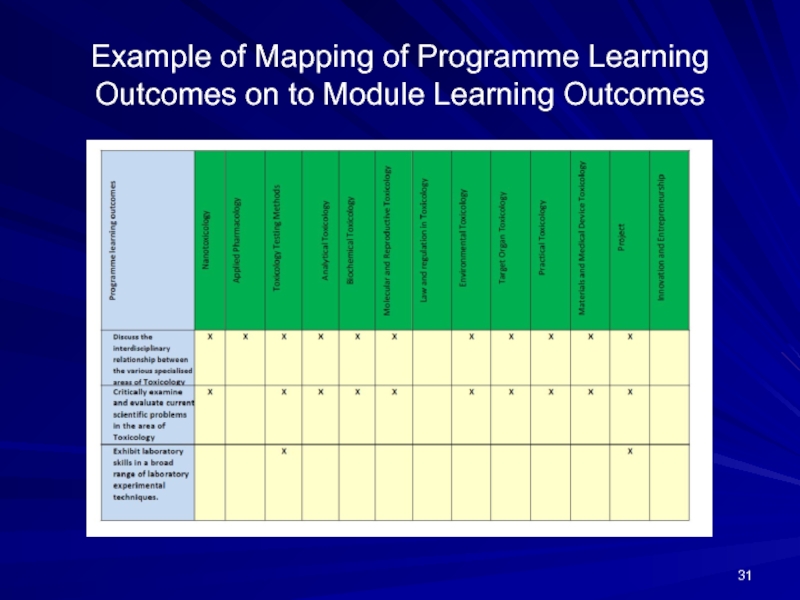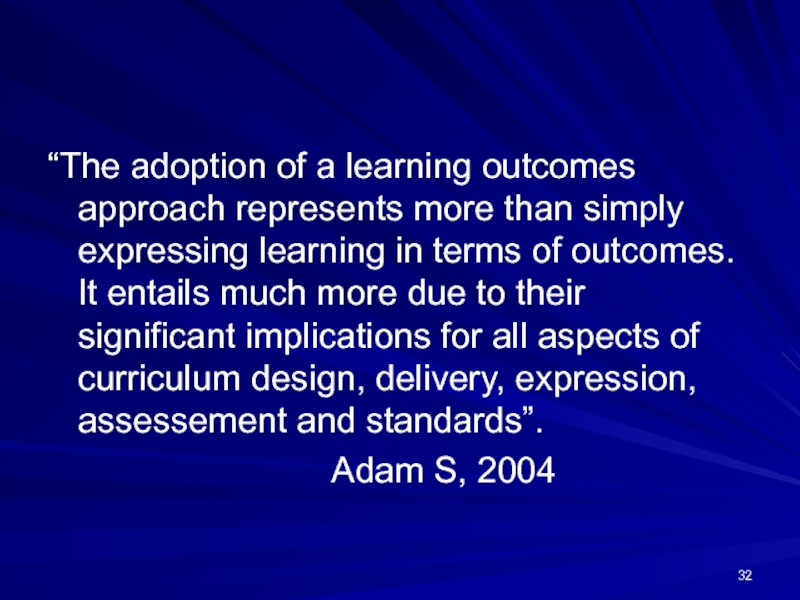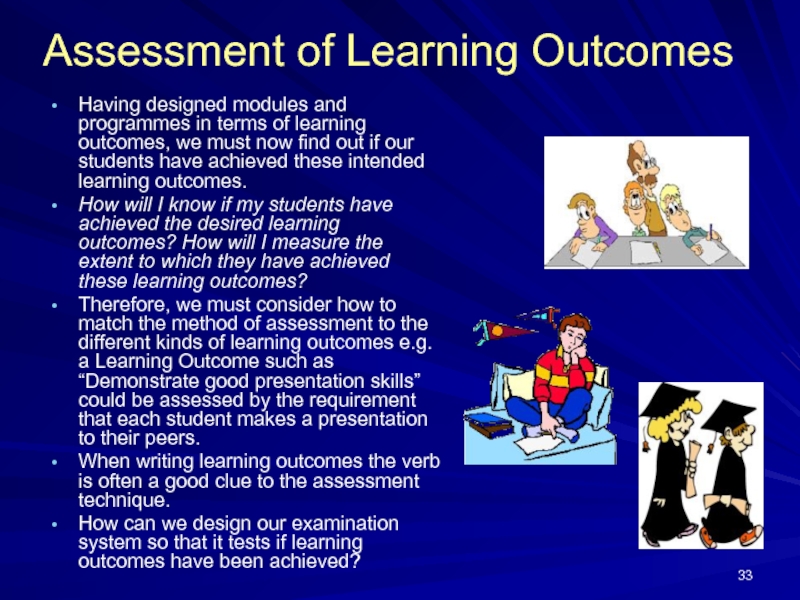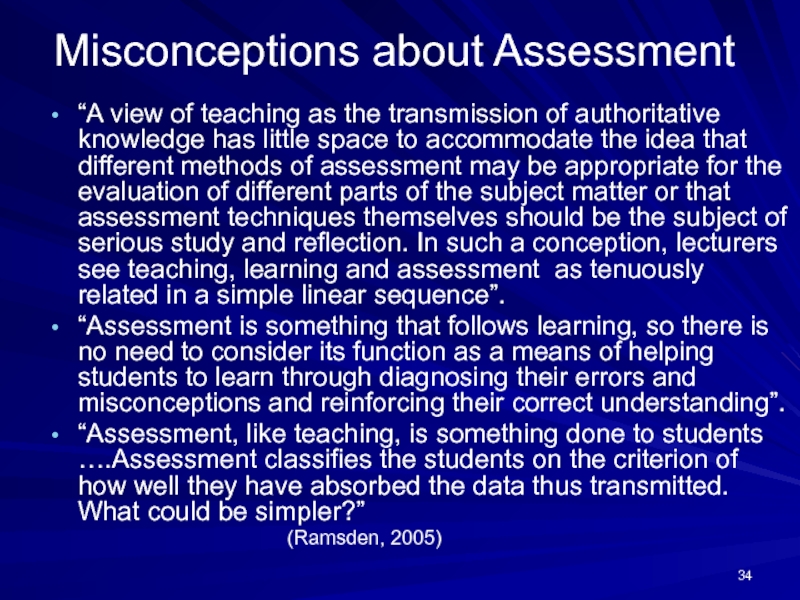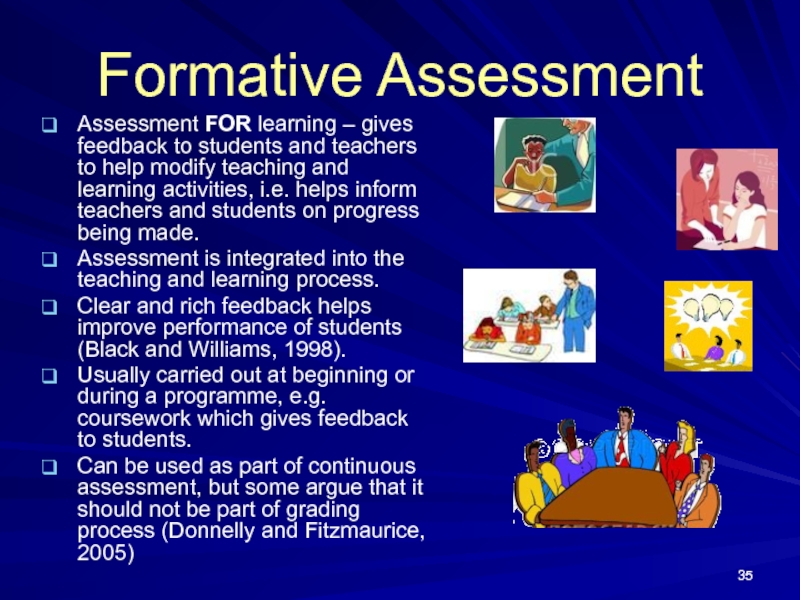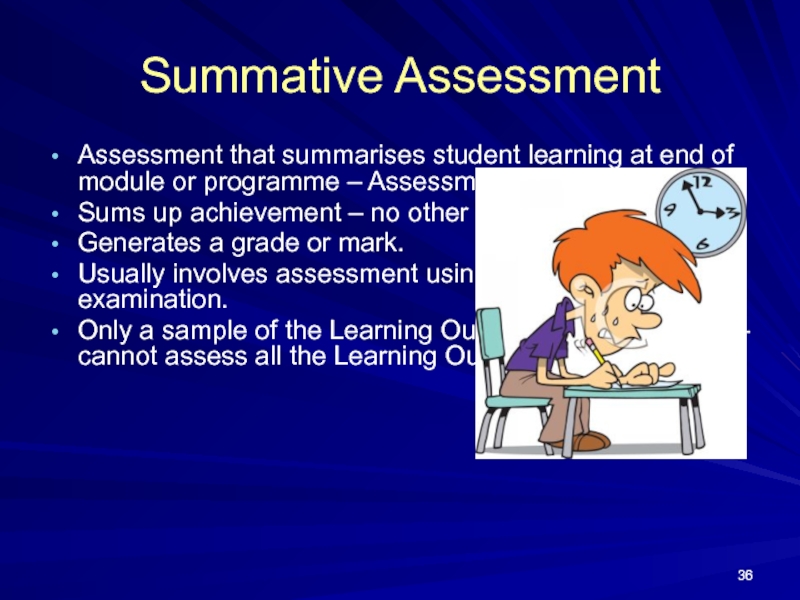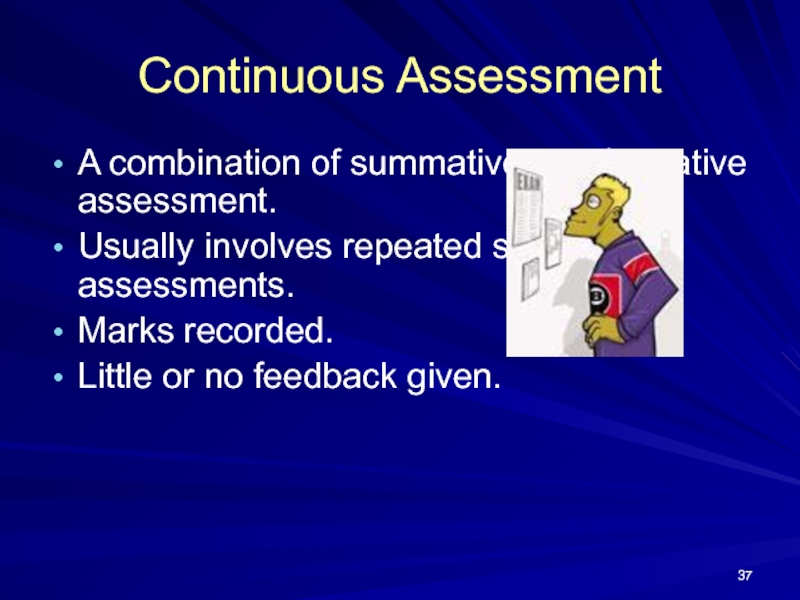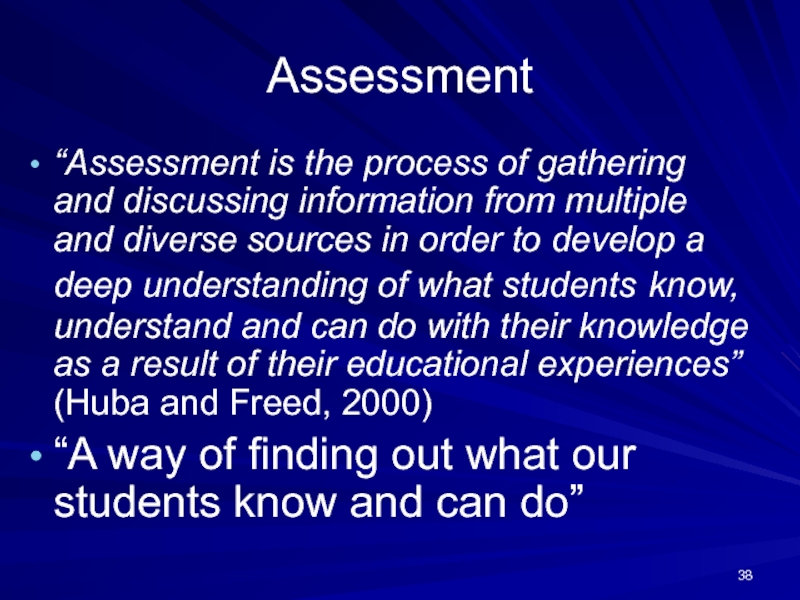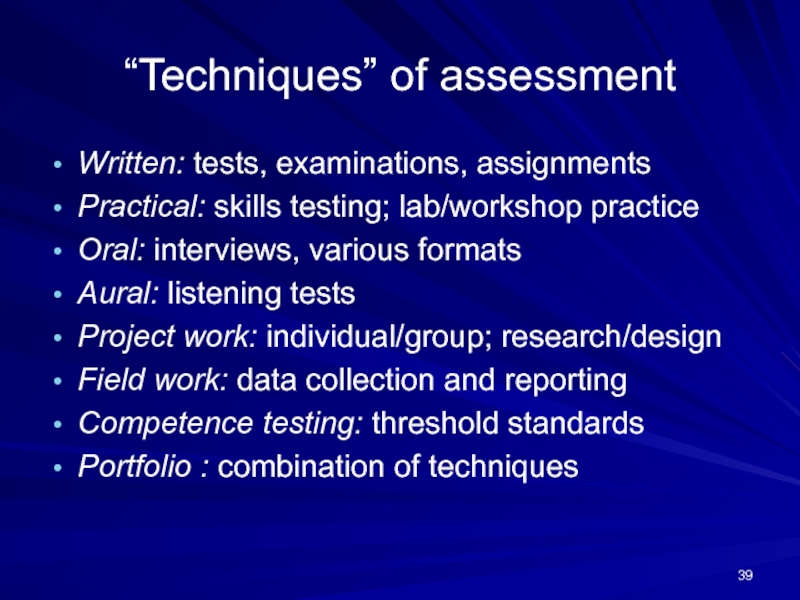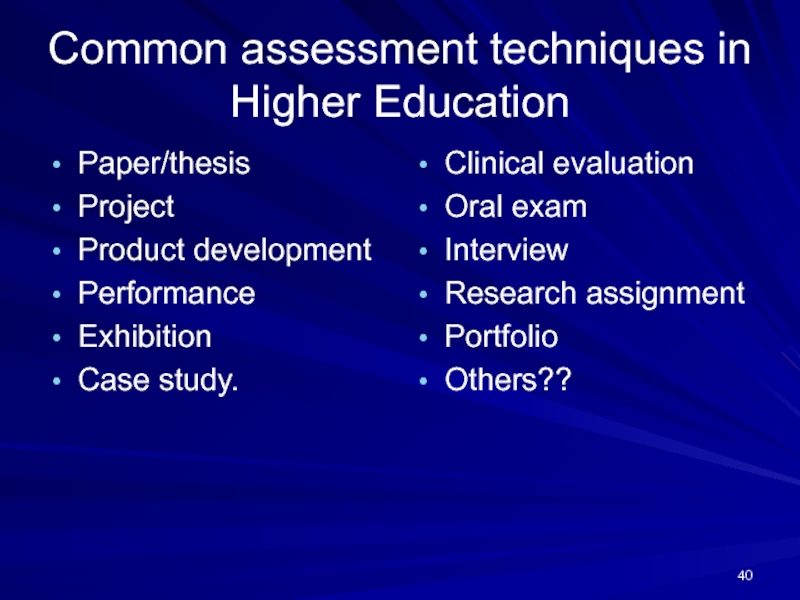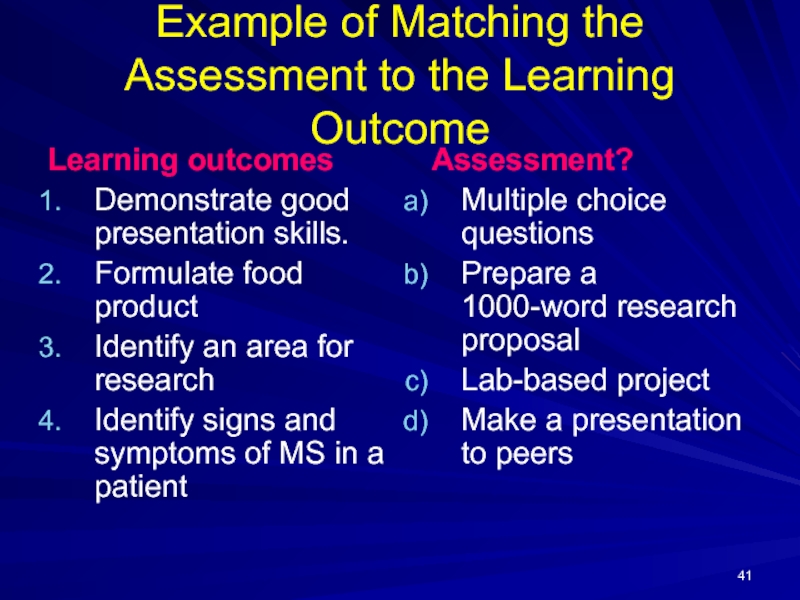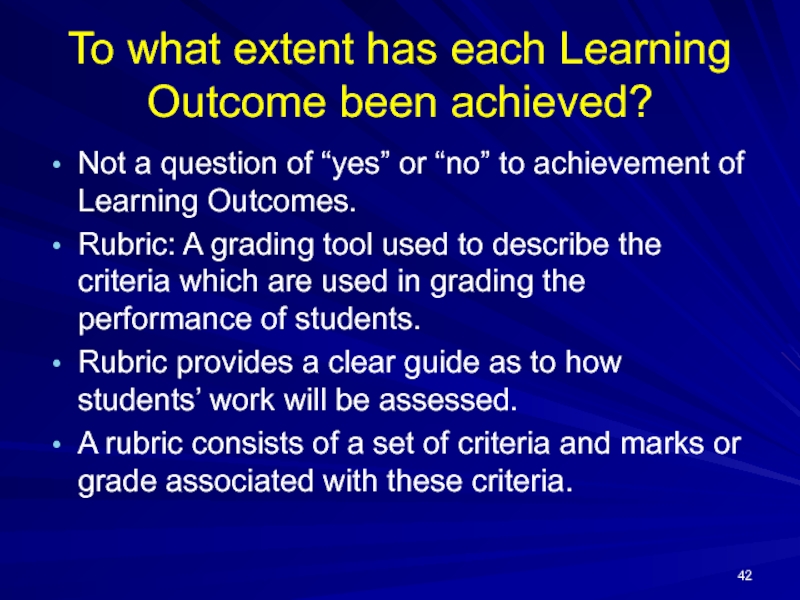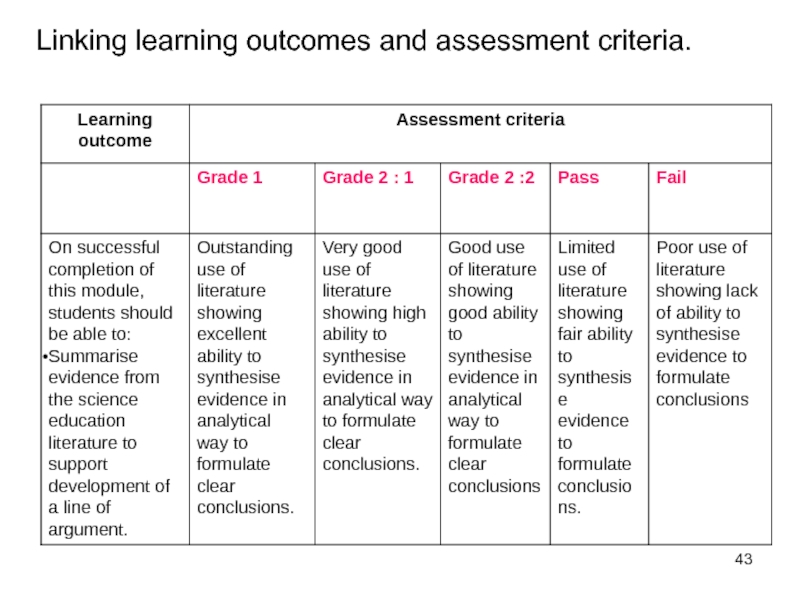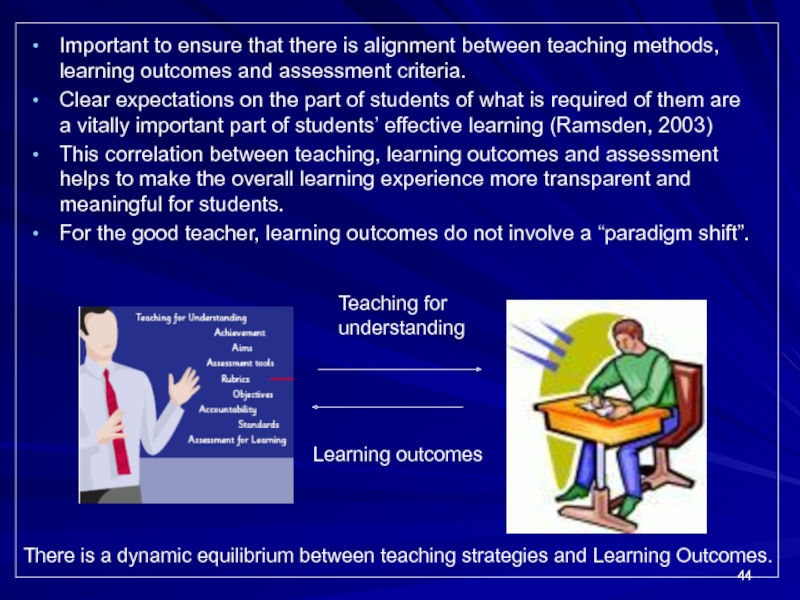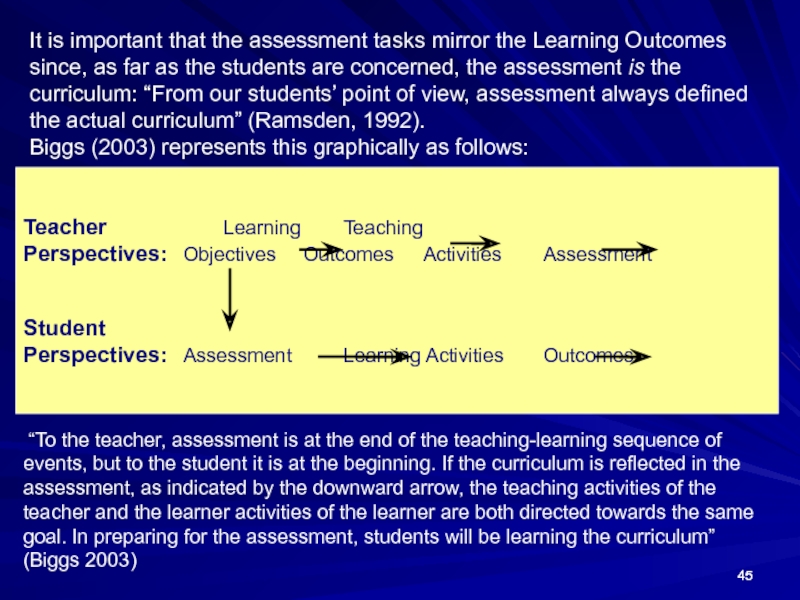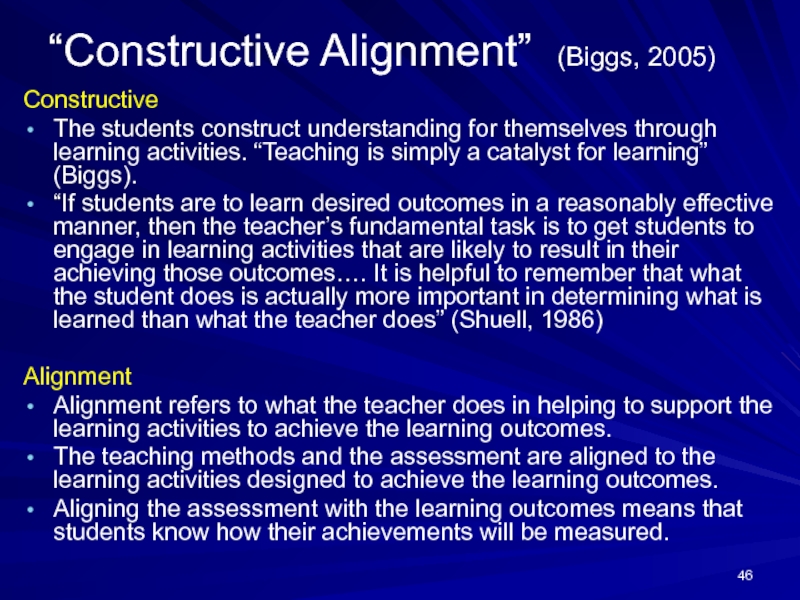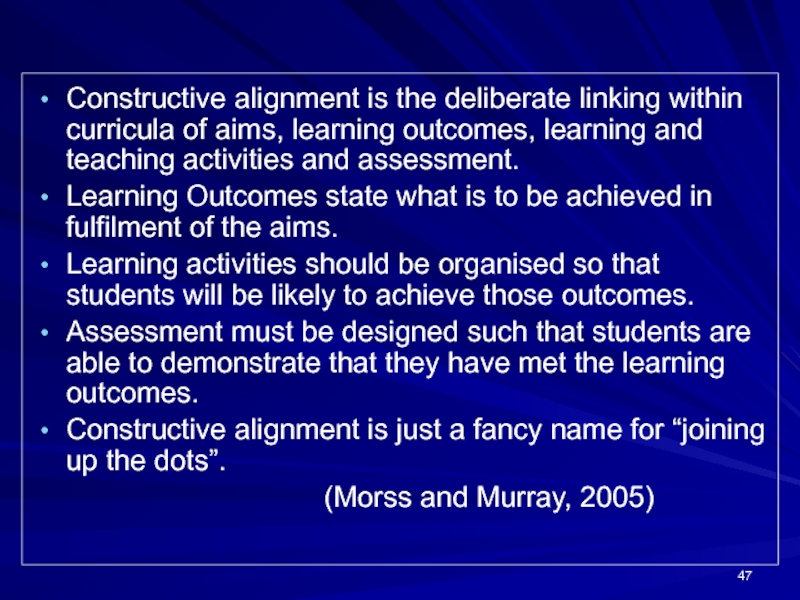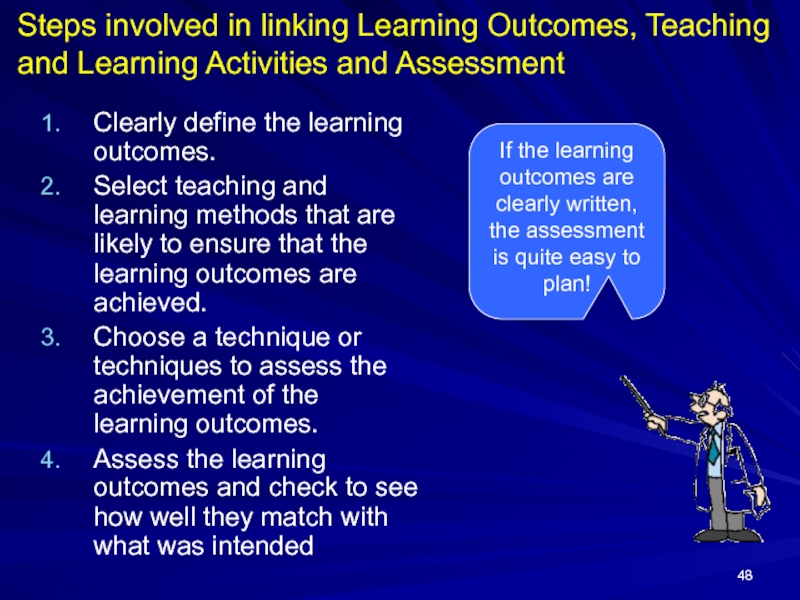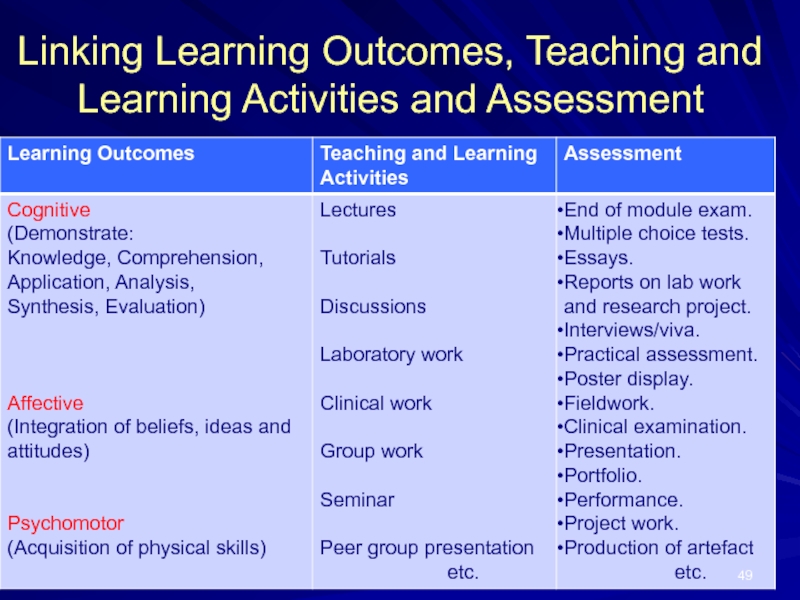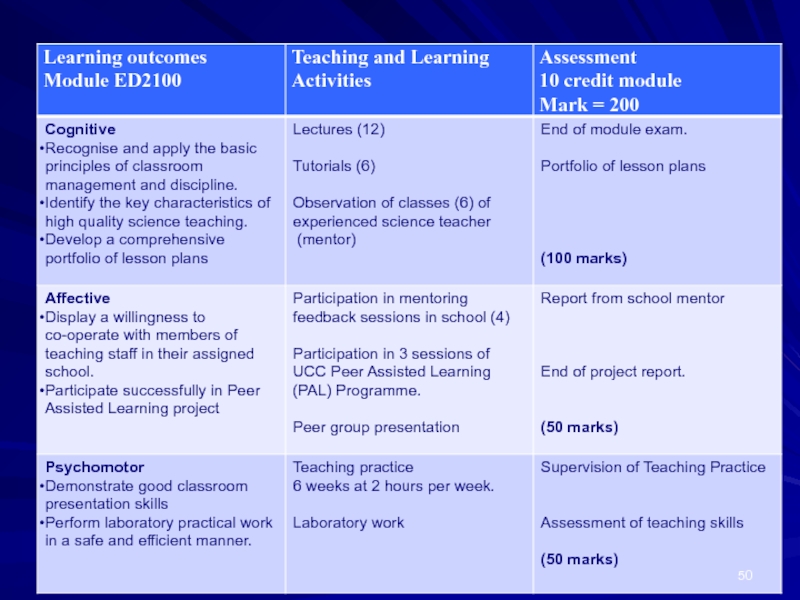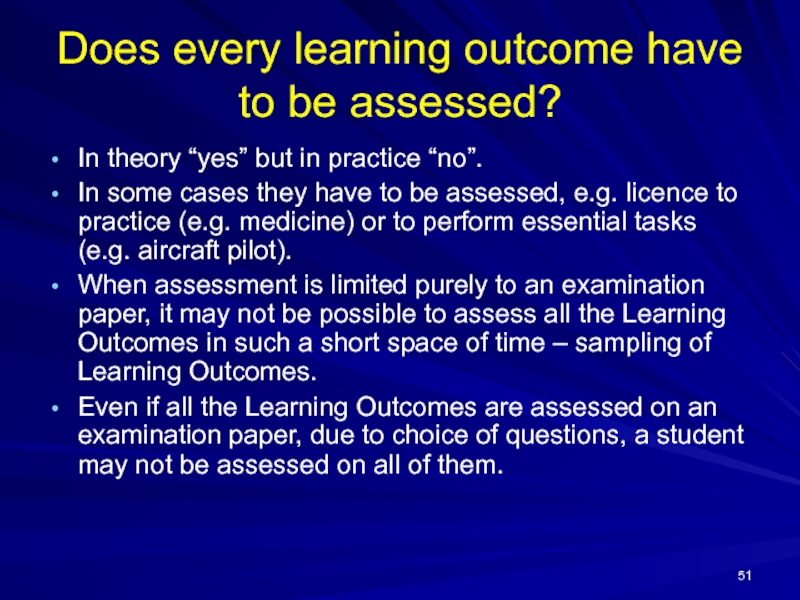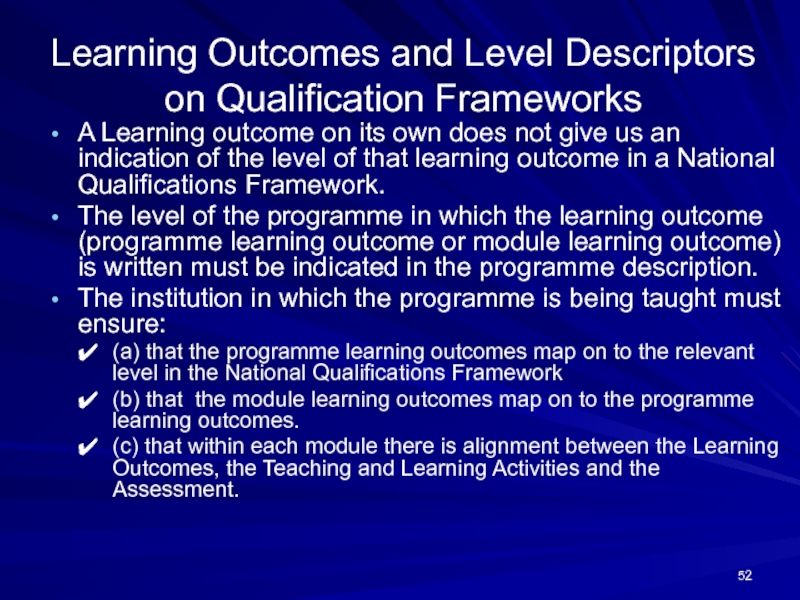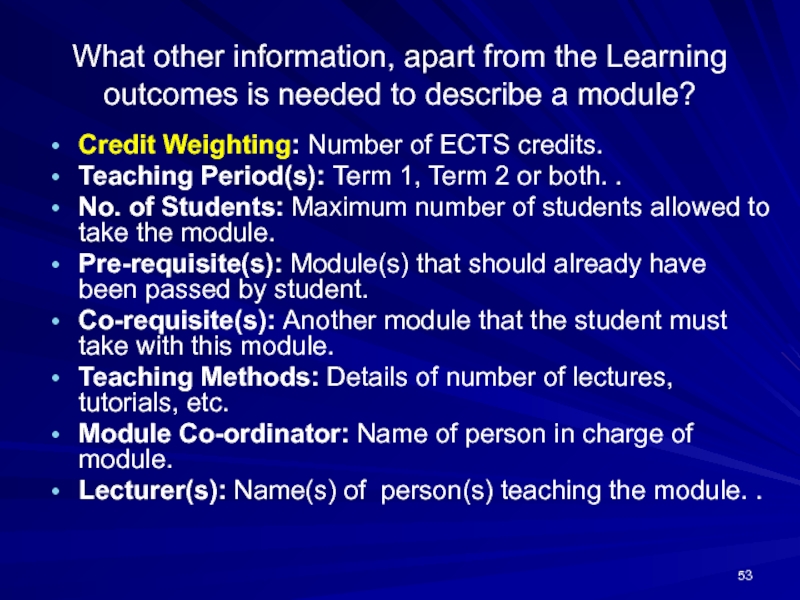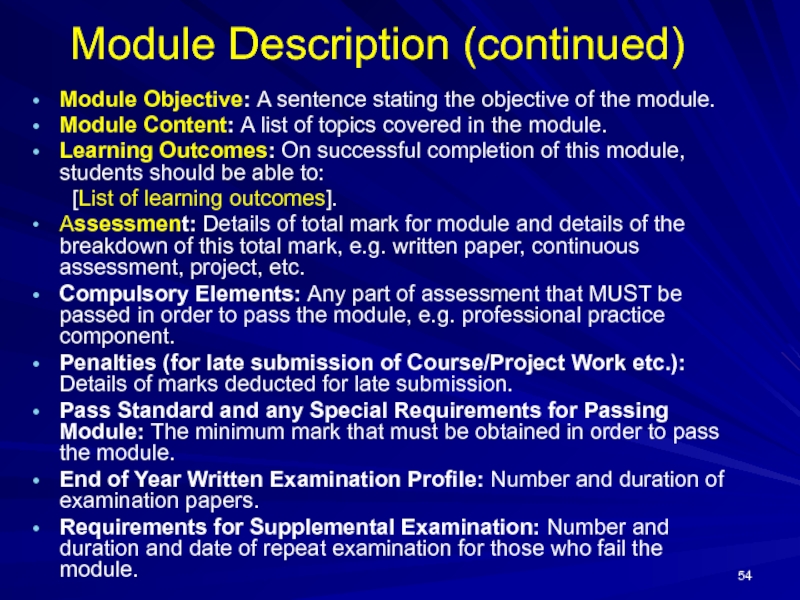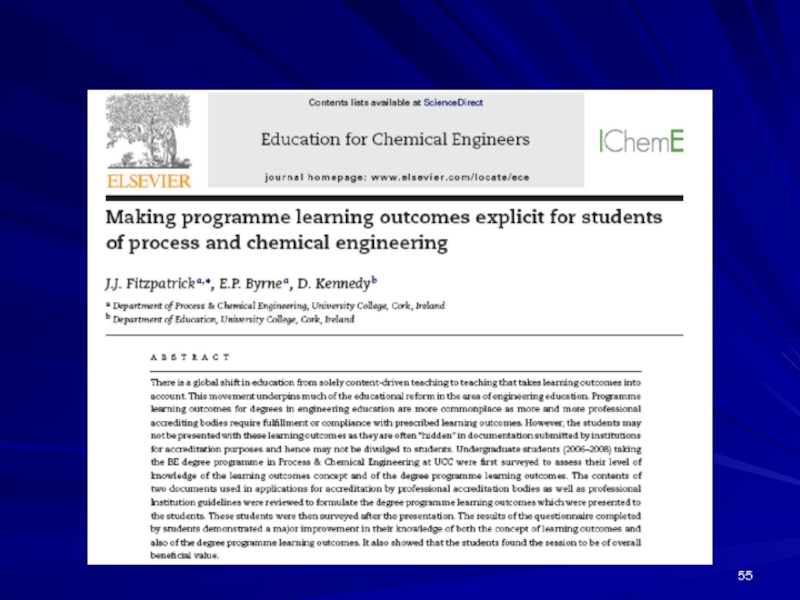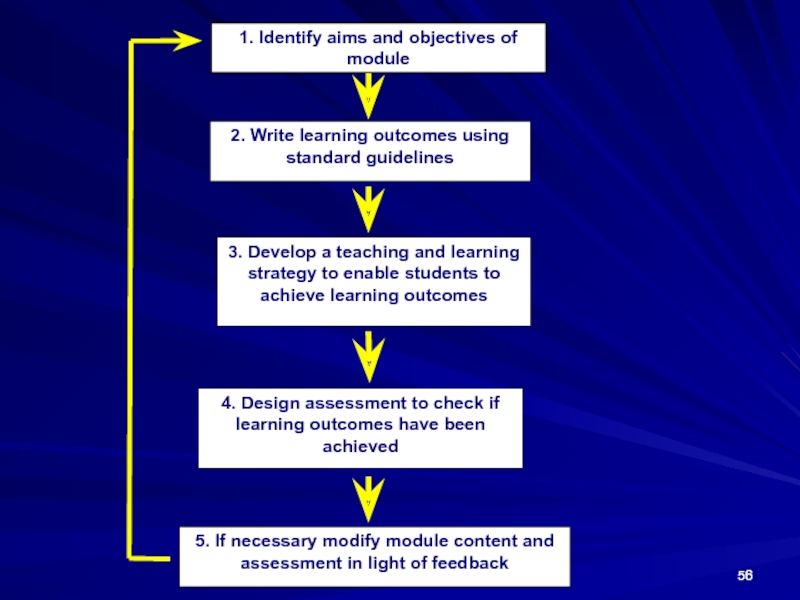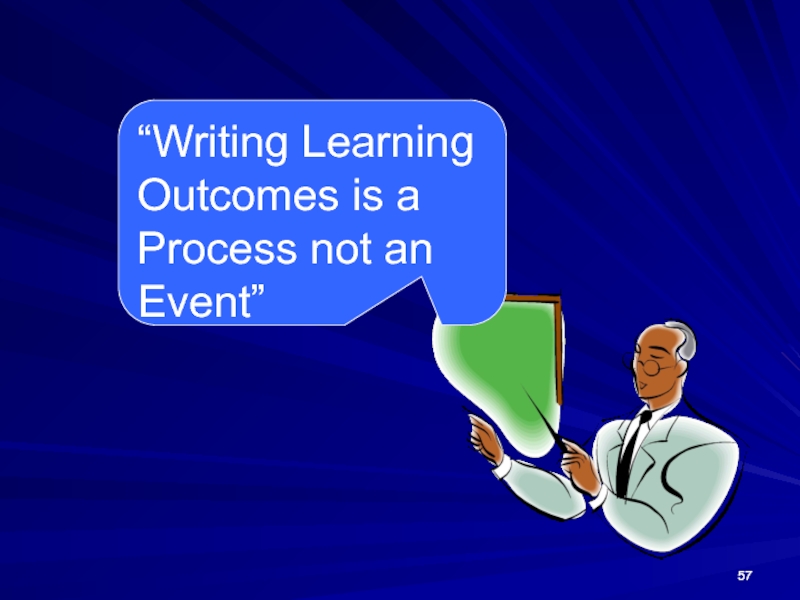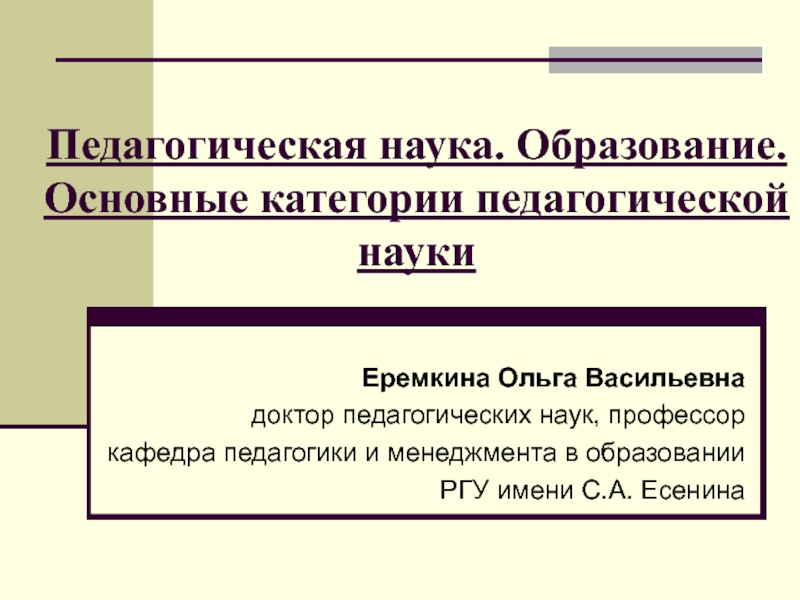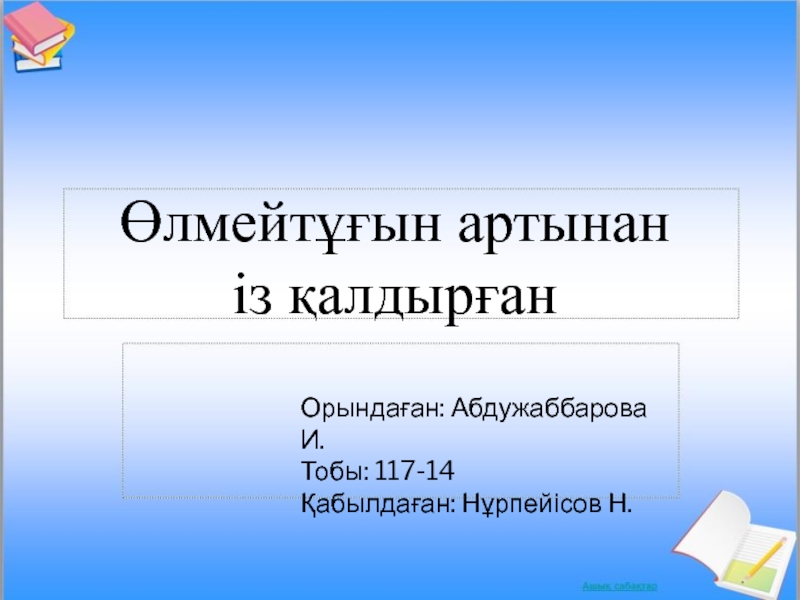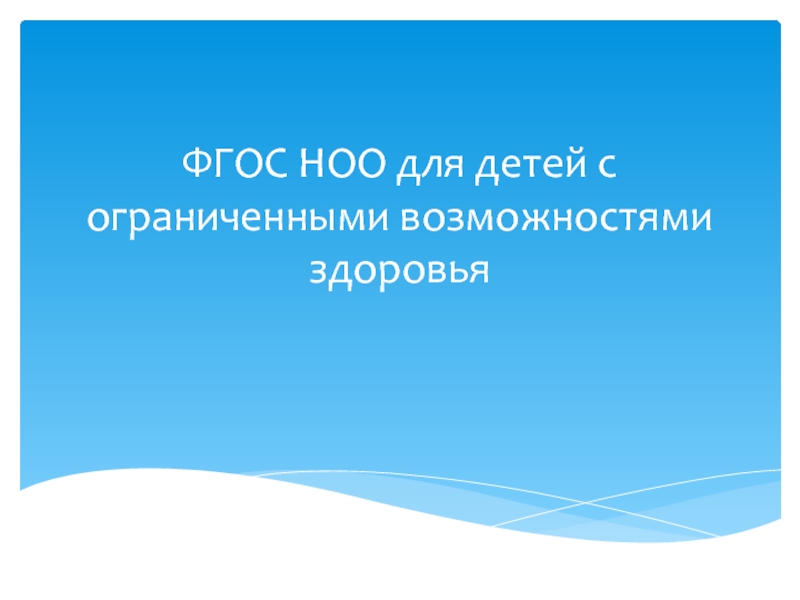- Главная
- Разное
- Дизайн
- Бизнес и предпринимательство
- Аналитика
- Образование
- Развлечения
- Красота и здоровье
- Финансы
- Государство
- Путешествия
- Спорт
- Недвижимость
- Армия
- Графика
- Культурология
- Еда и кулинария
- Лингвистика
- Английский язык
- Астрономия
- Алгебра
- Биология
- География
- Детские презентации
- Информатика
- История
- Литература
- Маркетинг
- Математика
- Медицина
- Менеджмент
- Музыка
- МХК
- Немецкий язык
- ОБЖ
- Обществознание
- Окружающий мир
- Педагогика
- Русский язык
- Технология
- Физика
- Философия
- Химия
- Шаблоны, картинки для презентаций
- Экология
- Экономика
- Юриспруденция
How do I link Learning Outcomes to Teaching and Learning Activities and to Assessment презентация
Содержание
- 1. How do I link Learning Outcomes to Teaching and Learning Activities and to Assessment
- 2. Framework of Qualifications for European Higher Education
- 3. Dublin Descriptors Descriptors drawn
- 4. First Cycle : Bachelor’s Cycle [180 –
- 5. Second Cycle: Master’s cycle [60 –
- 6. Third Cycle: Doctoral cycle [Number of
- 7. Time involved in various cycles Bachelor’s degree
- 8. European Qualifications Framework for Lifelong Learning (EQF)
- 9. Country A Country B
- 12. Some Further Points about EQF The 8
- 13. The EQF supports providers of education and
- 15. Relationship between Dublin Descriptors of Bologna Process
- 16. National Framework of Qualifications Putting the Bologna
- 17. Paperwork for Programme Recognition, Accreditation and Review
- 20. Language for writing Programme Learning Outcomes for
- 21. Knowledge - Kind Recognise limitations in the
- 22. Know-How and Skill - Range Apply a
- 23. Know How and Skill – Selectivity Select
- 24. Competence - Context Combine technical skills to
- 25. Competence Role Work as a member of
- 26. Competence - Learning to Learn Apply appropriate
- 27. Competence - Insight Recognise the relationship between
- 28. MAPPING OF PROGRAMME LEARNING OUTCOMES TO MODULE LEARNING OUTCOMES
- 30. Grid to show mapping of Programme Learning Outcomes on to Module Learning Outcomes
- 31. Example of Mapping of Programme Learning Outcomes on to Module Learning Outcomes
- 32. “The adoption of a learning outcomes approach
- 33. Assessment of Learning Outcomes Having designed modules
- 34. Misconceptions about Assessment “A view of
- 35. Formative Assessment Assessment FOR learning – gives
- 36. Summative Assessment Assessment that summarises student learning
- 37. Continuous Assessment A combination of summative and
- 38. Assessment “Assessment is the process of gathering
- 39. “Techniques” of assessment Written: tests, examinations,
- 40. Common assessment techniques in Higher Education Paper/thesis
- 41. Example of Matching the Assessment to the
- 42. To what extent has each Learning Outcome
- 43. Linking learning outcomes and assessment criteria.
- 44. Important to ensure that there is alignment
- 45. Teacher Learning Teaching Perspectives: Objectives Outcomes Activities Assessment
- 46. “Constructive Alignment” (Biggs, 2005) Constructive The students
- 47. Constructive alignment is the deliberate linking within
- 48. Steps involved in linking Learning Outcomes, Teaching
- 49. Linking Learning Outcomes, Teaching and Learning Activities and Assessment
- 51. Does every learning outcome have to be
- 52. Learning Outcomes and Level Descriptors on Qualification
- 53. What other information, apart from the Learning
- 54. Module Description (continued) Module Objective: A sentence
- 56. 1. Identify aims and objectives of module
- 57. “Writing Learning Outcomes is a Process not an Event”
Слайд 2Framework of Qualifications for European Higher Education Area (EHEA)
Conference of European
This framework shows
- Three cycles (including within national contexts, the possibility of intermediate qualifications)
- Generic descriptors for each cycle based on learning outcomes and competences.
- ECTS credit ranges in the first and second cycles (i.e. Bachelors and Masters levels).
Ministers committed themselves to drawing up National Frameworks for Qualifications compatible with Framework of Qualifications for European Higher Education area by 2010.
Bergen, Norway (2005)
Слайд 3 Dublin Descriptors
Descriptors drawn up at meeting of Education
These generic descriptors are used in The Framework for Qualifications of EHEA (Bologna Process). Adopted in 2005.
The Descriptors are generic statements that assist us to write Learning Outcomes.
Слайд 4First Cycle : Bachelor’s Cycle
[180 – 240 ECTS credits]
Minimum of 3
4 years = 240 credits.
Слайд 6Third Cycle: Doctoral cycle
[Number of ECTS credits not specified]
See two
www.ond.vlaanderen.be/hogeronderwijs/bologna/documents/Framework_qualificationsforEHEA-May2005.pdf
Слайд 7Time involved in various cycles
Bachelor’s degree = 3 or 4 years
Master’s
Doctoral degree = 3 years
Each of the three Bologna cycles is described in terms of learning outcomes as outlined in the “Dublin descriptors” (2005).
Note: The three cycles are closer to models in the UK and Ireland than in many countries of continental Europe where the model is based on the Magister or Diploma.
Слайд 8European Qualifications Framework for Lifelong Learning (EQF)
Adopted by EU in 2008.
A
A “Translation Device” to make qualifications easier to understand.
Has 8 levels with a set of descriptors for each level. These descriptors describe the learning corresponding to each level under the heading of knowledge, skills and competence.
Слайд 12Some Further Points about EQF
The 8 levels span the full scale
Work started in 2004 in response to requests from member states.
The EQF is compatible with the EHEA framework and cycle descriptors of Bologna Process.
Whilst the Bologna descriptors were developed specifically for higher education, the EQF is a lifelong learning framework.
The EQF emphasises the results of learning rather than focussing on inputs such as length of study.
The EQF defines a learning outcome as “a statement of what a learner knows, understands and is able to do on completion of a learning process”.
Each of the 8 reference levels are described in terms of learning outcomes.
.
Слайд 13The EQF supports providers of education and training by increasing transparency
The EU recommends enhanced cooperation in vocational education and training within the EQF.
The EQF describes levels of qualifications. It does not award qualifications. Awarding of qualifications is still left to national qualification bodies.
Main users of EQF will be bodies in charge of national and/or sectoral qualification systems and frameworks.
Generic descriptors of Bologna cycles and EQF are not specific enough to be used as programme learning outcomes.
Слайд 15Relationship between Dublin Descriptors of Bologna Process and reference levels of
Слайд 16National Framework of Qualifications
Putting the Bologna Process into practice.
A national framework
(EQF 2008)
Слайд 20Language for writing Programme Learning Outcomes for NQF
Knowledge - Breadth
Discuss a
Outline a broad range of fundamental concepts…..
Describe the theories and concepts in the field of….
Identify a range of processes used in….
Discuss relationships between the various areas of…..
Слайд 21Knowledge - Kind
Recognise limitations in the areas of…
Link relevant theories to
Utilise appropriate models and techniques in the area of …. to
Examine current theory in the area of…
Critique modern theories in the area of ….
Examine and evaluate current problems in the area of …..
Слайд 22Know-How and Skill - Range
Apply a range of techniques to solve…
Modify
Link theory with practice in order to…
Analyse data to facilitate decision making in the area of…
Utilise appropriate methods, skills and techniques to solve….
Exhibit proficiency in using a broad range of routine laboratory techniques in the field of…..
Слайд 23Know How and Skill – Selectivity
Select and apply the most suitable
Apply appropriate decision making to achieve high standards of performance in the area of….
Identify appropriate solutions to plan future developments in the area of…
Select appropriate instrumental methods to…
Utilise existing stragies to design……
Evaluate existing problems in the area of ….in order to….
Слайд 24Competence - Context
Combine technical skills to define a problem in the
Apply technical knowledge in the area of … to solve problems related to…
Recognise existing strategies to facilitate solutions in the area of…..
Formulate options and solutions to…
Diagnose problems and suggest solutions in the area of….
Transfer methodologies to new applications in the area of…..
Integrate a range of acquired transferable skills such as …….
Слайд 25Competence Role
Work as a member of a team to manage….
Initiate research
Implement work objectives and exercise leadership in …..
Interpret relevant regulations in the area of ..
Accept accountability for achieving…
Work autonomously or as a member of a team in order to…..
Слайд 26Competence - Learning to Learn
Apply appropriate ethical considerations.
Work ethically and professionally
Act appropriately in unfamiliar situations in the area of….
Develop your personal capabilities in order to ….
Engage with new developments and practices in order to…
Recognise the need for life-long learning and professional development in the area of….
Identify and address continuing requirements for professional development in the area of
Contribute to the future development of the field of…….
Слайд 27Competence - Insight
Recognise the relationship between science, technology and society in
Display an appropriate standard of professional practice in the area of…
Critically appraise research in the area of…. and evaluate the work of peers.
Embrace responsibiity for the welfare of others….
Display personal ethical standards in the area of…
Articulate and defend the need for personal responsibility and ethical considerations in the workplace for…..
Слайд 32“The adoption of a learning outcomes approach represents more than simply
Adam S, 2004
Слайд 33Assessment of Learning Outcomes
Having designed modules and programmes in terms of
How will I know if my students have achieved the desired learning outcomes? How will I measure the extent to which they have achieved these learning outcomes?
Therefore, we must consider how to match the method of assessment to the different kinds of learning outcomes e.g. a Learning Outcome such as “Demonstrate good presentation skills” could be assessed by the requirement that each student makes a presentation to their peers.
When writing learning outcomes the verb is often a good clue to the assessment technique.
How can we design our examination system so that it tests if learning outcomes have been achieved?
Слайд 34Misconceptions about Assessment
“A view of teaching as the transmission of
“Assessment is something that follows learning, so there is no need to consider its function as a means of helping students to learn through diagnosing their errors and misconceptions and reinforcing their correct understanding”.
“Assessment, like teaching, is something done to students ….Assessment classifies the students on the criterion of how well they have absorbed the data thus transmitted. What could be simpler?”
(Ramsden, 2005)
Слайд 35Formative Assessment
Assessment FOR learning – gives feedback to students and teachers
Assessment is integrated into the teaching and learning process.
Clear and rich feedback helps improve performance of students (Black and Williams, 1998).
Usually carried out at beginning or during a programme, e.g. coursework which gives feedback to students.
Can be used as part of continuous assessment, but some argue that it should not be part of grading process (Donnelly and Fitzmaurice, 2005)
Слайд 36Summative Assessment
Assessment that summarises student learning at end of module or
Sums up achievement – no other use.
Generates a grade or mark.
Usually involves assessment using the traditional examination.
Only a sample of the Learning Outcomes are assessed – cannot assess all the Learning Outcomes.
Слайд 37Continuous Assessment
A combination of summative and formative assessment.
Usually involves repeated
Marks recorded.
Little or no feedback given.
Слайд 38Assessment
“Assessment is the process of gathering and discussing information from multiple
“A way of finding out what our students know and can do”
Слайд 39“Techniques” of assessment
Written: tests, examinations, assignments
Practical: skills testing; lab/workshop practice
Oral:
Aural: listening tests
Project work: individual/group; research/design
Field work: data collection and reporting
Competence testing: threshold standards
Portfolio : combination of techniques
Слайд 40Common assessment techniques in Higher Education
Paper/thesis
Project
Product development
Performance
Exhibition
Case study.
Clinical evaluation
Oral exam
Interview
Research assignment
Portfolio
Others??
Слайд 41Example of Matching the Assessment to the Learning Outcome
Learning outcomes
Demonstrate
Formulate food product
Identify an area for research
Identify signs and symptoms of MS in a patient
Assessment?
Multiple choice questions
Prepare a 1000-word research proposal
Lab-based project
Make a presentation to peers
Слайд 42To what extent has each Learning Outcome been achieved?
Not a question
Rubric: A grading tool used to describe the criteria which are used in grading the performance of students.
Rubric provides a clear guide as to how students’ work will be assessed.
A rubric consists of a set of criteria and marks or grade associated with these criteria.
Слайд 44Important to ensure that there is alignment between teaching methods, learning
Clear expectations on the part of students of what is required of them are a vitally important part of students’ effective learning (Ramsden, 2003)
This correlation between teaching, learning outcomes and assessment helps to make the overall learning experience more transparent and meaningful for students.
For the good teacher, learning outcomes do not involve a “paradigm shift”.
Teaching for
understanding
Learning outcomes
There is a dynamic equilibrium between teaching strategies and Learning Outcomes.
Слайд 45Teacher Learning Teaching
Perspectives: Objectives Outcomes Activities Assessment
Student
Perspectives: Assessment Learning Activities Outcomes
It is important that the assessment tasks
Biggs (2003) represents this graphically as follows:
“To the teacher, assessment is at the end of the teaching-learning sequence of events, but to the student it is at the beginning. If the curriculum is reflected in the assessment, as indicated by the downward arrow, the teaching activities of the teacher and the learner activities of the learner are both directed towards the same goal. In preparing for the assessment, students will be learning the curriculum” (Biggs 2003)
Слайд 46“Constructive Alignment” (Biggs, 2005)
Constructive
The students construct understanding for themselves through learning
“If students are to learn desired outcomes in a reasonably effective manner, then the teacher’s fundamental task is to get students to engage in learning activities that are likely to result in their achieving those outcomes…. It is helpful to remember that what the student does is actually more important in determining what is learned than what the teacher does” (Shuell, 1986)
Alignment
Alignment refers to what the teacher does in helping to support the learning activities to achieve the learning outcomes.
The teaching methods and the assessment are aligned to the learning activities designed to achieve the learning outcomes.
Aligning the assessment with the learning outcomes means that students know how their achievements will be measured.
Слайд 47Constructive alignment is the deliberate linking within curricula of aims, learning
Learning Outcomes state what is to be achieved in fulfilment of the aims.
Learning activities should be organised so that students will be likely to achieve those outcomes.
Assessment must be designed such that students are able to demonstrate that they have met the learning outcomes.
Constructive alignment is just a fancy name for “joining up the dots”.
(Morss and Murray, 2005)
Слайд 48Steps involved in linking Learning Outcomes, Teaching and Learning Activities and
Clearly define the learning outcomes.
Select teaching and learning methods that are likely to ensure that the learning outcomes are achieved.
Choose a technique or techniques to assess the achievement of the learning outcomes.
Assess the learning outcomes and check to see how well they match with what was intended
If the learning outcomes are clearly written, the assessment is quite easy to plan!
Слайд 51Does every learning outcome have to be assessed?
In theory “yes” but
In some cases they have to be assessed, e.g. licence to practice (e.g. medicine) or to perform essential tasks (e.g. aircraft pilot).
When assessment is limited purely to an examination paper, it may not be possible to assess all the Learning Outcomes in such a short space of time – sampling of Learning Outcomes.
Even if all the Learning Outcomes are assessed on an examination paper, due to choice of questions, a student may not be assessed on all of them.
Слайд 52Learning Outcomes and Level Descriptors on Qualification Frameworks
A Learning outcome on
The level of the programme in which the learning outcome (programme learning outcome or module learning outcome) is written must be indicated in the programme description.
The institution in which the programme is being taught must ensure:
(a) that the programme learning outcomes map on to the relevant level in the National Qualifications Framework
(b) that the module learning outcomes map on to the programme learning outcomes.
(c) that within each module there is alignment between the Learning Outcomes, the Teaching and Learning Activities and the Assessment.
Слайд 53What other information, apart from the Learning outcomes is needed to
Credit Weighting: Number of ECTS credits.
Teaching Period(s): Term 1, Term 2 or both. .
No. of Students: Maximum number of students allowed to take the module.
Pre-requisite(s): Module(s) that should already have been passed by student.
Co-requisite(s): Another module that the student must take with this module.
Teaching Methods: Details of number of lectures, tutorials, etc.
Module Co-ordinator: Name of person in charge of module.
Lecturer(s): Name(s) of person(s) teaching the module. .
Слайд 54Module Description (continued)
Module Objective: A sentence stating the objective of the
Module Content: A list of topics covered in the module.
Learning Outcomes: On successful completion of this module, students should be able to:
[List of learning outcomes].
Assessment: Details of total mark for module and details of the breakdown of this total mark, e.g. written paper, continuous assessment, project, etc.
Compulsory Elements: Any part of assessment that MUST be passed in order to pass the module, e.g. professional practice component.
Penalties (for late submission of Course/Project Work etc.): Details of marks deducted for late submission.
Pass Standard and any Special Requirements for Passing Module: The minimum mark that must be obtained in order to pass the module.
End of Year Written Examination Profile: Number and duration of examination papers.
Requirements for Supplemental Examination: Number and duration and date of repeat examination for those who fail the module.
Слайд 561. Identify aims and objectives of module
2. Write learning outcomes using
3. Develop a teaching and learning strategy to enable students to achieve learning outcomes
4. Design assessment to check if learning outcomes have been achieved
5. If necessary modify module content and assessment in light of feedback
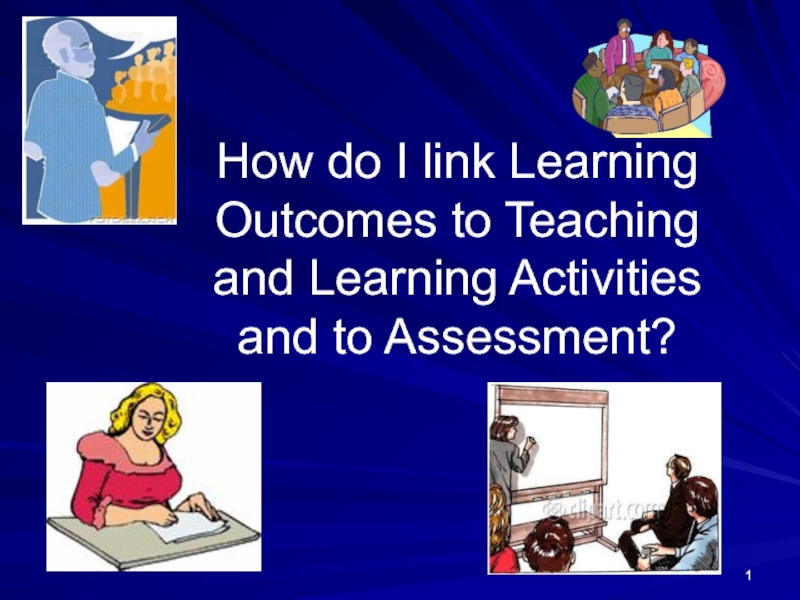

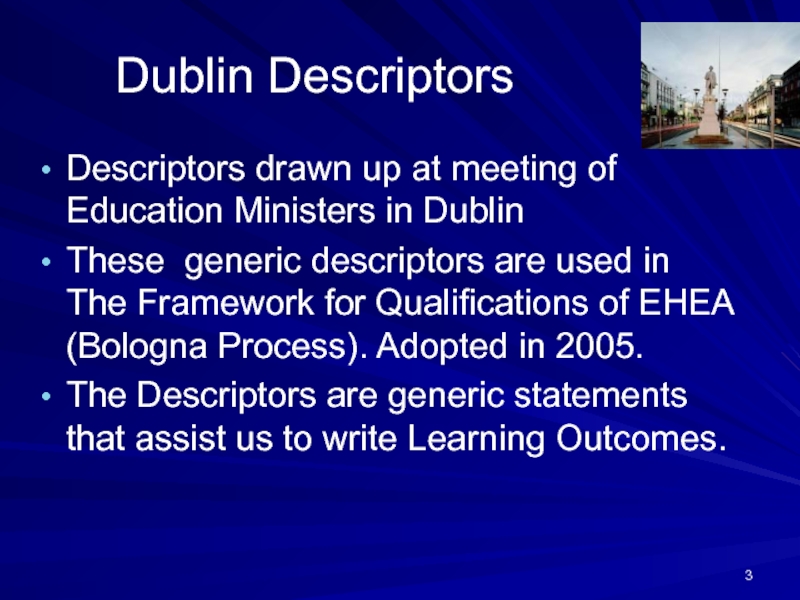
![First Cycle : Bachelor’s Cycle[180 – 240 ECTS credits]Minimum of 3 years = 180 credits4](/img/tmb/5/442586/257877383fa42d1dabb5be92855122b6-800x.jpg)
![Second Cycle: Master’s cycle [60 – 120 ECTS credits]1 year or 2 years](/img/tmb/5/442586/f6ebbe2319728234af622d4da411c358-800x.jpg)
![Third Cycle: Doctoral cycle [Number of ECTS credits not specified]See two page summary of framework](/img/tmb/5/442586/f85713cbc32e8285036e45b5054a077a-800x.jpg)
